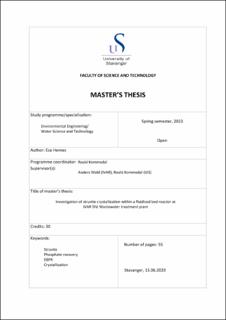| dc.description.abstract | This study investigates the struvite crystallization method for phosphorus recovery from IVAR SNJ wastewater treatment plant. The physicochemical properties of struvite, including its crystallization mechanics and the influence of wastewater conditions, are examined.
Different molar ratios of struvite components were tested along with pH with batch reactor and fluidized bed reactor. Additionally, Visual MINTEQ modelling is implemented to examine the effect of molar ratios. The results indicated that a molar ratio of Mg-NH4-PO4 of 1,5-1,5-1 for the struvite components yielded optimal performance in terms of struvite crystallization.
The correlation between effluent orthophosphate concentration and pH were examined. Based on the findings, pH 8,5 to 9 is recommended for operation of the struvite reactor.
To implement a potential struvite crystallization reactor at the IVAR SNJ wastewater treatment plant, the plan involves directing all reject water from the secondary treatment's thickening process (BR) into the reactor. Based on this, the other flows that will be directed to the struvite reactor are calculated using average concentrations of struvite components in the centrifuge reject water (SR) and BR. The molar ratio of Mg-NH4-PO4 is set to 1,5-1,5-1, and a hydraulic retention time (HRT) of 2 hours is targeted. For a flow rate of 500 m3/d and a phosphate load of 250 mg/l in BR, the optimal quantities determined are 54 m3/d of 1 M magnesium solution and 96 m3/d of centrifuge reject water. Additionally, NaOH adjustments for pH control are estimated to be 9,72 l/d of 1 M NaOH solution. The calculated volume of the full-scale reactor is 55 m3. With these operating parameters, it is anticipated that the harvested struvite from the reactor would amount to 932 kg/d for a wastewater flow rate of 100000 m3/d. Achieving a 90% efficiency in phosphate removal is feasible with the selected operation factors.
The outcomes of this study contribute to the advancement of sustainable wastewater management practices and the promotion of sustainability. By optimizing the struvite crystallization process and understanding its relationship with effluent orthophosphate concentration and pH, this research provides insights for large-scale implementation.
In conclusion, this study highlights the potential of the struvite crystallization method for phosphorus recovery, with strong correlations observed between effluent orthophosphate concentration and pH. | |
